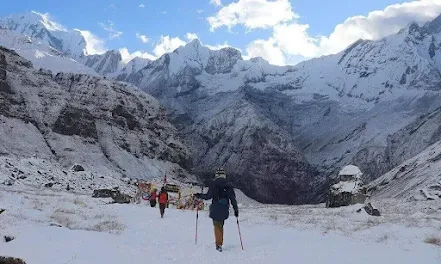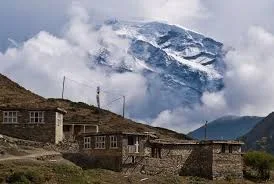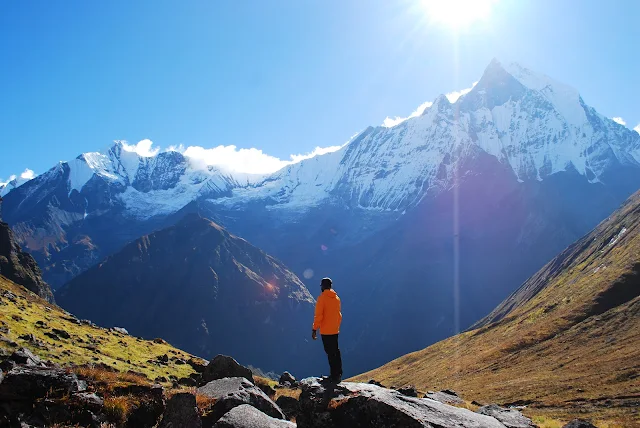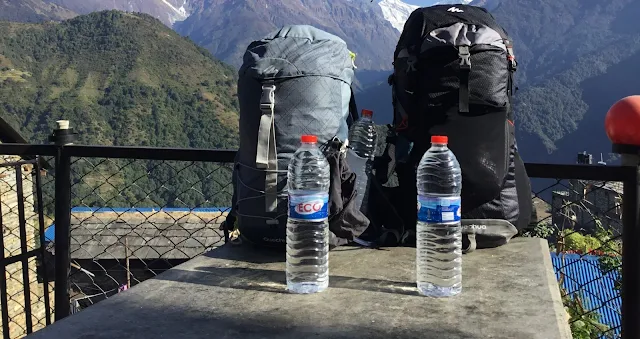You must go to the Nepal Tourism Board's office in Pokhara or Kathmandu to receive the permits. You can also obtain them at the Annapurna Conservation Area Project (ACAP) office or the Trekking Agencies' Association of Nepal (TAAN) office.
- Valid passport with at least six months of validity
- Two passport-sized photos
- Trekking itinerary
- Trekking agency recommendation letter (if you are hiring a guide or
porter)
Annapurna Circuit Trek Logistics
In Nepal, the Annapurna Circuit Trek is a well-known and established trekking path. The following information about the trek's logistics should be noted.
Trekking Itinerary: An average Annapurna Circuit Trek takes 15 to 20 days to complete. Besisahar is the starting point of the walk, and Pokhara is where it comes to an end. The 230-kilometer walk travels through a variety of environments, including lush green woods, dry deserts, and high mountain ranges.
Accommodation: Along the trekking path, there are many teahouses and hotels that provide trekkers simple lodging options. Depending on the location and altitude, the quality of the accommodations can change. You may anticipate to find reasonably decent lodges with standard services like wifi and hot showers in lower altitudes. But at higher altitudes, the lodges might not have running water, and the accommodations might become spartan and chilly.
Food and Water: Along the trekking path, there are many restaurants and teahouses serving a selection of regional and foreign cuisines. The majority of teahouses also sell snacks and beverages. Since tap water might not be suitable for drinking, it is advised to bring a water filter or purification tablets to cleanse the water before drinking.
Weather: The months of March through May and September through November are the ideal times to hike the Annapurna Circuit. The weather is often calm and dry during these months, with bright sky and comfortable temperatures. However, especially at higher altitudes, you should be ready for rapid weather changes.
Gear and Equipments: Warm clothing, supportive hiking boots, a backpack, a sleeping bag, a trekking pole, a headlamp and a water bottle are just a few of the items you'll need to bring. It is advised to bring only what is necessary and to pack lightly.
 |
| Equipment for trekking in Annapurna |
Guide and Porter: While it is feasible to walk the Annapurna Circuit without a guide or porter, doing so can ease the difficulty and improve the experience. A porter may carry your bulky bag so you can concentrate on the trek while a guide can share insightful knowledge about the trekking path, the local culture, and history.
Permits: Before beginning the trek, you must get all relevant permits, including the Trekker's Information Management System (TIMS) card and the Annapurna Conservation Area Permit (ACAP).
What to pack for the Annapurna Circuit Trek?
It might be difficult to pack for the Annapurna Circuit Trek since you need to balance carrying everything you need with trying to keep your rucksack as light as possible. The following are some necessities you should think about taking on the trek:
Clothing: Pack clothing for both warm and cold weather since the weather on the Annapurna Circuit Trek can be erratic. Warm down jacket, thermal underwear, fleece jacket, trekking pants, shorts, waterproof pants, gloves, warm hat, and sun hat should all be included in your luggage. It is advisable to dress in layers so that you can change your attire when the temperature changes.
 |
| Clothing lists for trekking |
Foot Wears: You should bring strong, comfy hiking boots with good ankle support. Additionally, remember to bring a pair of relaxed sandals or trainers to walk around the teahouses in the evenings in.
Backpack and Accessories: You should bring a cosy rucksack with a minimum 50-liter capacity. Also recommended are a trekking pole, a water bottle or hydration bladder, a headlight or torch, sunglasses and a waterproof cover for your backpack.
Sleeping Gears: Because the nights can get very cold at higher altitudes, you will need a decent quality sleeping bag rated for temperatures below freezing. A sleeping mat could be useful to have in your luggage for added comfort.
Personal Hygiene: Pack toilet paper, wet wipes, hand sanitizer, a toothbrush, toothpaste, and other personal hygiene supplies. It's crucial to bring a first aid kit with you that is composed of materials like bandages, pain relievers, antiseptic cream, and altitude sickness remedies.
Technology: Even if you want to disconnect and enjoy nature while on the walk, you might want to include a camera to record the breathtaking vistas. Additionally, bring a power bank so you can keep your electronics charged.
Cash: You should bring enough money to cover all of your trek-related expenses, such as food, drink, and lodging.
 |
| Nepali 1 thousand |
Keep in mind that you will be carrying everything on your back for the duration of the walk, so pack lightly and only bring what you need.
How to reach Annapurna Circuit Trek?
Fly to Kathmandu, the nation's capital, to go to the Annapurna Circuit Trek's starting point. From there, you can drive or take a domestic aircraft to Pokhara, which serves as the entry point to the Annapurna region.
 |
| Helicopter for Annapurna |
You can hire a private jeep or take a local bus from Pokhara to get to the village of Besisahar, which is often where the trip begins. By car, the trip from Pokhara to Besisahar takes about 6-7 hours.
As an alternative, a jeep that travels straight from Kathmandu to Besisahar will take you there in 8 to 9 hours. However, compared to taking a local aircraft to Pokhara and then driving by road from there, this route may be more expensive and less convenient.
 |
| Car for hire for trekking |
Once you arrive in Besisahar, you may begin your walk by taking the clearly designated path through the breathtaking Annapurna region. Depending on your pace and itinerary, the trek can be finished in 14–21 days. As the Annapurna Circuit walk is a high-altitude walk with heights of over 5,000 metres, it is crucial to adequately acclimatise and gear up for the trek.
 |
| Trekking in Annapurna route |
Before beginning your adventure, you should confirm that you have all the required permissions and supplies.
Having a pre-trek meeting with your guide or tour operator to go over the specifics of your journey and ask any questions is also advised.
Problems that are faced during the Annapurna Circuit Trek
Before beginning the Annapurna Circuit Trek, it's necessary to be aware of the difficulties and hardships that lie ahead. The Annapurna Circuit Trek has to deal with a number of significant problems, such as.
Over Crowd: Over the years, the Annapurna Circuit Trek has grown in popularity, which has resulted in crowding on the trail during the busiest trekking seasons. Long lines on the trail and a less pleasurable hiking experience may result from this.
Environmental Degradation: The Annapurna Circuit Trek has seen an increase in trekkers, which has negatively impacted the ecosystem, especially in the form of trash and inappropriate garbage disposal. For the sake of preserving the area's natural beauty, trekkers must engage in ethical and sustainable practices.
Difficulty in Acclimatization: The high heights reached on the Annapurna Circuit Trek can be challenging to acclimatize to. Trekkers should understand the signs of altitude sickness and take the necessary actions to prevent it.
Limited Facilities: Although there are teahouses and lodges along the trail, in some places the amenities can be sparse and limited. Trekkers should pack their own food and water if necessary and be ready for basic lodgings.
Road Constructions: The Annapurna Circuit Trek route has had road work recently, which may have an impact on the hiking experience. The enlargement of the trail, increased traffic, and noise pollution brought on by the development may take away from the trek's tranquilly and natural beauty.
.jpeg) |
| Roads of Annapurna region |
Language Barrier: The Annapurna Circuit Trek traverses a number of isolated communities where locals might not understand English. This may complicate communication and present a problem in terms of placing food orders, making travel arrangements, and contacting help in an emergency.
Why do People choose Annapurna Circuit Trek over Annapurna Base Camp Trek?
There are various reasons why people might prefer the Annapurna Circuit Trek to the Annapurna Base Camp Trek for several reasons of the following elements could have an impact on their choice:
Scenic Diversity: The Annapurna Circuit Trek is renowned for its astounding variety of scenery. The Annapurna and Dhaulagiri mountain ranges, as well as the lush woods, scenic valleys, and traditional Nepalese villages, are all visible from here. Compared to the
Annapurna Base Camp journey, which largely concentrates on the Annapurna Sanctuary, the journey covers a greater distance and traverses a variety of regions, offering a wider spectrum of natural beauty.
Cultural Experience: Trekkers can interact with many ethnic communities along the Annapurna Circuit Trek and immerse themselves in the local culture. The Gurung, Thakali, and Manangi people live in a number of the villages along the trail, providing opportunity to examine their distinctive lifestyles, traditions, and architectural styles. Compared to the Annapurna Base Camp Trek, the cultural experience on the Annapurna Circuit Trek may be more comprehensive and varied.
Off-The-Beaten-Track Encounter: The Annapurna Circuit Trek offers a more off-the-beaten-path experience while the Annapurna Base Camp Trek draws a sizable number of trekkers each year. Trekkers can explore more distant and less populated areas on the circuit route because it spans a larger area and includes lesser-traveled paths. For those looking for a more sedate trekking experience, this might heighten the feeling of adventure and seclusion.
 |
| off-beaten-paths of Annapurna |
Physical Challenge: In terms of time and elevation gain, the Annapurna Circuit Trek is often regarded as being more difficult than the Annapurna Base Camp Trek. The Thorong La Pass, which must be traversed throughout the circuit trip and is located at an elevation of 5,416 metres (17,769 feet), calls for good physical condition and acclimatisation. The increased physical difficulty and sense of satisfaction that comes from completing the circuit may be preferred by some trekkers.
Time Commitment: Compared to the Annapurna Base Camp Trek, the Annapurna Circuit Trek is a lengthier trek. While the base camp journey can be completed in around 10–12 days, the circuit trek typically takes 18–21 days. To maximize their hiking experience, hikers may choose the Annapurna Circuit if they have more time available for their expedition.
Outline Itinerary for Annapurna Circuit Trek
Day 01: Welcome to Kathmandu.
Day 02: Explore Kathmandu valley and prepare for the trek.
Day 03: Drive from Kathmandu to Besisahar.
Day 04: Trek from Besisahar or Khudi to Sirung (2200m)
Day 05: Trek from Sirung to Jagat (1330m)
Day 06: Trek from Jagat to Dharapani (1960m)
Day 07: Trek from Dharapani to Chame (2720m).
Day 08: Trek from Chame to Pisang (3190m).
Day 09: Trek from Pisang to Manang (3540m).
Day 10: Acclimatization day at Manang.
Day 11: Trek from Manang to Yak Kharka (4210m).
Day 12: Trek from Yak Kharka to Thorung- La Phedi (4450m).
Day 13: Trek from Thorung Phedi to Muktinath (3710m) crossing Thorang La pass (5416m).
Day 14: Trek from Muktinath to Kagbeni (2780m).
Day 15: Trek from Kagbeni to Jomsom (2725m).
Day 16: Drive or Fly from Jomsom all the way to Pokhara.
Day 17: Exploration day at Pokhara.
Day 18: Early morning scenic drive back to Kathmandu.
Day 19: Departure
If you’re interested to know more about this trek, visit our page on the Annapurna Circuit Trek which includes comprehensive details on trail routes, highlights of Annapurna Circuit Trek, detailed itinerary, what to bring, recommended gear, and much more.











.jpeg)




Comments
Post a Comment